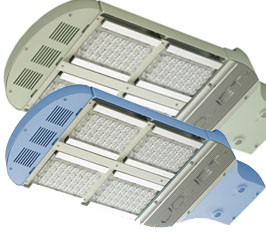One modern miracle is the common streetlight, making it safer to walk the streets at night for example. But streetlights are costly for cities to maintain, consume a lot of electricity, and because electricity is usually generated by burning fossil fuels, streetlights indirectly cause nasty environmental side effects. According to a study released the Northeast Group on Monday, LED streetlights (light emitting diode streetlights) have a high rate of satisfaction, while saving 60% on energy and maintenance costs.

The study, “United States Smart Infrastructure: LED and Smart Street Lighting,” was the result of a survey of over 100 cities that have implemented some form of LED streetlight initiative.
“LED streetlights are transforming cities and municipalities across the US,” said Northeast Group. “Not only are LEDs helping save money through reduced energy and maintenance costs, but 95% of the cities and municipalities we surveyed said both they and residents were very happy with the performance and light quality of the new streetlights. Many reported that law enforcement officials in particular had praised the lights for improving visibility and public safety. The success of these LED projects is also helping to set the stage for more advanced ‘smart’ street lighting systems, which will reduce energy consumption by a further 20-30%. In total, the LED and smart street lighting markets are expected to reach a cumulative $4.7 billion in the US by 2025.
LED lighting generally consumes a fraction (about 1%) of the electricity of regular lighting, while each LED light unit will have a lifetime 100 times or more longer than regular lights.
The study identified 400 U.S. cities that have already begun or had considered installing LED streetlights. The study found that 25 LED streetlight vendors are already active serving this market.
The study also identified a hurdle facing the adoption of LED streetlights. Most existing deployments were funded by stimulus funding from the American Recovery and Reinvestment Act (ARRA). That funding is receding, making financing for future LED streetlight projects has been more difficult to secure, despite the success of early projects. However the price for LED streetlights is falling, and is expected to fall enough that within a few years to reach price parity with traditional streetlights. At that point the payback period, where cost savings pay for the LED streetlight costs, will be short enough to be within the reach of budget-constrained cities and municipalities.
The future for this form of street lighting is bright as most existing deployments are pilot projects. “Perhaps the most surprising finding in our survey was that most cities had only converted a small percentage of their streetlights to LEDs, even though they’ve been extremely popular,” added Northeast Group. “It was hard to find any detractors from these projects, yet LED penetration remains below 1% of the overall streetlight population in the US. Certainly, some hurdles, such as financing, remain. But overall these findings show that the market has vast growth potential.”
LED streetlights offer a new dimension of usefulness that traditional streetlights do not. LED lights can turn on and off instantly, and readily dimmable. This paves the way for smart streetlights reduce energy consumption through dimming, improve billing, and enable remote monitoring features. Cities that have already installed communications networks for related smart grid infrastructure can take advantage of existing installations to lower overall costs.
PG&E’s LED streetlight program cites these advantages:
- Improved night visibility due to higher color rendering, higher color temperature and increased illuminance uniformity
- Significantly longer lifespan
- Lower energy consumption
- Reduced maintenance costs
- Instant-on with no run-up or re-strike delays
- No mercury, lead or other known disposable hazards
- Lower environmental footprint
- An opportunity to implement programmable controls (e.g. bi-level lighting)
“Smart streetlights are the logical next step,” according to Northeast Group. “Current pilot projects such as in Chattanooga, Tennessee have demonstrated that smart streetlights improve safety while lowering costs. As more cities invest in LED streetlights and smart grid infrastructure, smart streetlights will help cities further reduce energy consumption. A majority of the cities in our survey were interested in pursuing smart streetlight systems in the future.”
- Is there enough Grid Capacity for Hydrogen Fuel Cell or Battery Electric cars? - April 23, 2023
- Is Tesla finagling to grab federal NEVI dollars for Supercharger network? - November 15, 2022
- Tesla announces the North American Charging Standard charging connector - November 11, 2022
- Lightning Motorcycles adopts Silicon battery, 5 minute charge time gives 135 miles range - November 9, 2022
- Tesla Autopilot under US Dept of Transportation scrutiny - June 13, 2022
- Spectacular CNG bus fire misrepresented as EV bus fire - April 21, 2022
- Moldova, Ukraine, Georgia, Russia, and the European Energy Crisis - December 21, 2021
- Li-Bridge leading the USA across lithium battery chasm - October 29, 2021
- USA increasing domestic lithium battery research and manufacturing - October 28, 2021
- Electrify America building USA/Canada-wide EV charging network - October 27, 2021














